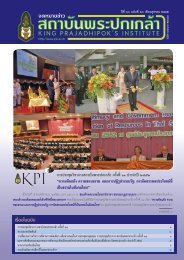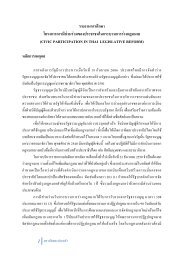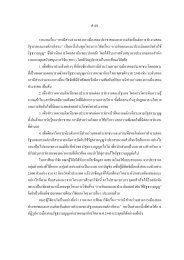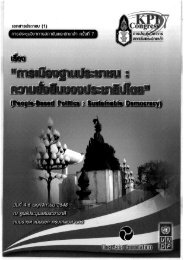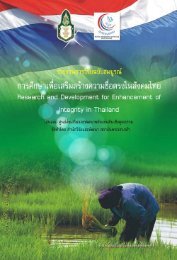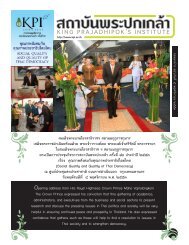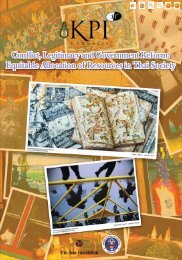SUFFiciENcy EcONOMy ANd GRASSROOtS DEvElOPMENt
SUFFiciENcy EcONOMy ANd GRASSROOtS DEvElOPMENt
SUFFiciENcy EcONOMy ANd GRASSROOtS DEvElOPMENt
You also want an ePaper? Increase the reach of your titles
YUMPU automatically turns print PDFs into web optimized ePapers that Google loves.
The Meaning of Sufficiency Economy <br />
International Conference<br />
281<br />
massive public works programme) to give them the needed additional incomes to<br />
reach the minimum. Around the same time a number of others discussed estimates of<br />
inequalities in income distribution, incidence of and trends in poverty, conceptual<br />
and measurement problems involved, and strategies for tackling poverty.<br />
This research highlighted significant differences in estimates of mean incomes<br />
and consumption, inequality indices and poverty incidence obtained from different<br />
sources. There was a major controversy over whether or not poverty incidence had<br />
declined during the 1960s. This stimulated serious investigation into theoretical<br />
aspects of concepts and measurements, the merits and weaknesses of different<br />
sources of relevant data, the interrelation between growth, distribution of assets and<br />
income, employment and poverty; and different strategies for rapid reduction of<br />
poverty. All these themes continue to figure prominently in the ever growing<br />
literature on this subject both nationally and internationally. The discussions have of<br />
course become more detailed, technically more refined and wider in scope. <br />
By the early 1970s, development economists, both within the country and<br />
abroad as well as in international agencies, had veered round to the view that overall<br />
growth, while necessary, would not by itself be able to take care of the needs of the<br />
poor. The pace of growth is unlikely to be uniform across regions; all segments of<br />
the economy and sections of the population are not integrated into the wider<br />
economy; and large sections are not equipped (for a variety of reasons) to take<br />
advantage of the opportunities arising from growth. Therefore programmes for<br />
‘direct tike the World Bank.<br />
This perception did not long remain a matter of academic interest. In India, the<br />
set back to the economy during the late 1960s, (slow growth, back in investment,<br />
inflation), heightened apprehensions of increased inequalities, growing<br />
unemployment and worsening of poverty. It Happened to coincide with the struggle<br />
for political power in the Congress Party. ‘Radical’ measures, (like bank<br />
nationalization abolition of privy purses) ostensibly meant to contain the rich, were<br />
tried but they were limited in scope and did not mean much to the poor. In this<br />
juncture, Indira Gandhi sought to broaden her political base by adopting the ‘Garibi<br />
Hatao’ slogan and launching a number of poverty alleviation schemes.<br />
Apart from a Minimum Needs Programme, a number of other initiatives -<br />
notably special schemes for small and marginal farmers (later replaced by Integrated<br />
Rural Development, IRDP for short), rural employment schemes, mid-day meals for<br />
school children, and subsidized public distribution of food and other essential<br />
commodities - were launched. Some were new; others essentially were refurbished<br />
versions of older schemes. That they did not remain slogans, but were backed by<br />
substantial financial allocations made them politically credible. That it struck a<br />
positive chord among the people is evident from the resounding electoral success of<br />
Congress Party under Indira Gandhi’s leadership.<br />
For the first time, assurance of basic minimum needs found an explicit and<br />
prominent place in the Fifth Plan. The concept included not only an assurance of



